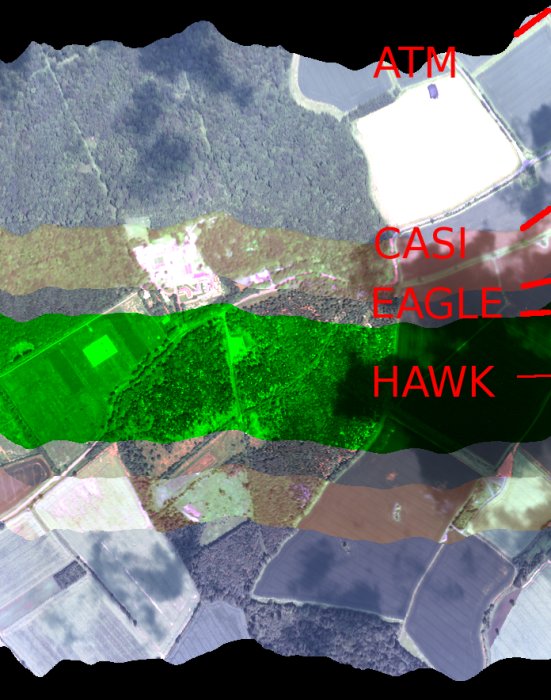| Version 12 (modified by mggr, 17 years ago) (diff) |
|---|
Sensors
Most of the useful information is currently on the main ARSF website - http://arsf.nerc.ac.uk/
Comparative swath widths (imaging instruments)
LIDAR
The Optec LIDAR operated up to 2008 was owned and processed by ULM - see Processing/LIDAR.
In 2008, ARSF purchased an ALS50 (phase II) LIDAR from Leica. More information is at:
- Sensors/LeicaLIDAR/MikesNotes - Mike's notes on the Leica training course in Aug 2008 (to be digested and turned into real wiki pages at some point in the future).
- Sensors/LeicaLIDAR/MarksNotes - Mark's bullet notes on the Leica training course in Aug 2008.
Specim
You can find a thesis covering the underlying principles of the Specim instruments (Eagle & Hawk) at http://www.vtt.fi/inf/pdf/publications/2001/P435.pdf
Hawk
Some details on Hawk's detector from Jukka @ Specim (email 25/July/2008):
The detector type on Hawk is MCT (Mercury-Cadmium-Telluride), which means that it's not a CCD that is typically used for VNIR spectral range. The manufacturer's specification for that MCT detector bad pixel is the following; if the pixel peak responsivity differs more than +/- 30% from average responsivity, it is considered to be bad. According to specification less than 2% of pixels should be bad. In practice that is from 0.3 to 1.0 %. The detector is sealed in a vacuum housing. This vacuum "leaks" very very slowly. As a result of this new bad pixels may appear. Eventually the vacuum has to be recovered using a special method. According to manufacturer it may take from 6 months to several years before this must be done. So far we've done this only for a single sensor, which had been used already for several years before that. By they way, there are no similar bad pixels on CCD used on Eagle. ... response to query from Ben re: frequency of maintenance: There is no particular way or time to say when that operation is due. You will get a hint from additional bad pixels. Also if the detector temperature is no longer as low as it used to be that could be an indication of impurity in the vacuum. You don't want to try that operation periodically. It requires sending the system here and disassembly of some parts. After that that the system must be reassembled and calibrated. I'm not expecting your system do be due for that operation yet. And I understand you are recalibrating the system at the moment. This means that new calibration file will "recover" most of the partially appearing bad pixels if any.
Notes of interest
Eagle uses a 1024x1024 CCD, but only the middle ~504 spectral pixels are used in normal operation (representing the range from ~390nm to ~950nm) and is normally spectrally binned by 2 (giving 252 bands).
However, when used with a band file for "calibration mode", the instrument returns the full data width (i.e. all 1024 pixels). This must be accounted for in any calibration code. (source: phone chat with Bill, 6/Nov/2007, much amended 30/Jul/2007 following corrections to Mike's interpretation from Bill)
Attachments (2)
-
all_sensors.jpg
(231.6 KB) -
added by mggr 17 years ago.
Comparison of swath widths
-
all_sensors-cropped.jpg
(85.6 KB) -
added by mggr 17 years ago.
Smaller version of swath width comparison
Download all attachments as: .zip
